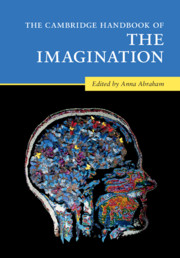Book contents
- The Cambridge Handbook of the Imagination
- The Cambridge Handbook of the Imagination
- Copyright page
- Dedication
- Contents
- Figures
- Contributors
- Acknowledgments
- 1 Surveying the Imagination Landscape
- Part I Theoretical Perspectives on the Imagination
- 2 The Evolution of a Human Imagination
- 3 Material Imagination: An Anthropological Perspective
- 4 The Archaeological Imagination
- 5 Philosophical Perspectives on Imagination in the Western Tradition
- 6 Imagination in Classical India: A Short Introduction
- 7 From Prediction to Imagination
- 8 Memory and Imagination: Perspectives on Constructive Episodic Simulation
- 9 Capturing the Imagination
- 10 A Sociocultural Perspective on Imagination
- 11 Artificial Intelligence and Imagination
- Part II Imagery-Based Forms of the Imagination
- Part III Intentionality-Based Forms of the Imagination
- Part IV Novel Combinatorial Forms of the Imagination
- Part V Phenomenology-Based Forms of the Imagination
- Part VI Altered States of the Imagination
- Name Index
- Subject Index
- References
2 - The Evolution of a Human Imagination
from Part I - Theoretical Perspectives on the Imagination
Published online by Cambridge University Press: 26 May 2020
- The Cambridge Handbook of the Imagination
- The Cambridge Handbook of the Imagination
- Copyright page
- Dedication
- Contents
- Figures
- Contributors
- Acknowledgments
- 1 Surveying the Imagination Landscape
- Part I Theoretical Perspectives on the Imagination
- 2 The Evolution of a Human Imagination
- 3 Material Imagination: An Anthropological Perspective
- 4 The Archaeological Imagination
- 5 Philosophical Perspectives on Imagination in the Western Tradition
- 6 Imagination in Classical India: A Short Introduction
- 7 From Prediction to Imagination
- 8 Memory and Imagination: Perspectives on Constructive Episodic Simulation
- 9 Capturing the Imagination
- 10 A Sociocultural Perspective on Imagination
- 11 Artificial Intelligence and Imagination
- Part II Imagery-Based Forms of the Imagination
- Part III Intentionality-Based Forms of the Imagination
- Part IV Novel Combinatorial Forms of the Imagination
- Part V Phenomenology-Based Forms of the Imagination
- Part VI Altered States of the Imagination
- Name Index
- Subject Index
- References
Summary
Humans can see the world around them, imagine how it might be different, and translate those imaginings into reality ‥ or at least try to. This ability plays a significant role in our lineage’s evolutionary success. Meaning, imagination, and hope are as central to the human evolutionary story as are bones, genes, and ecologies. Paleoanthropological, archaeological, and biological data make it abundantly clear that the human lineage, over the last 2 million years, has undergone specific morphological changes alongside less easily measurable, but significant behavioral and cognitive shifts as it has forged and been shaped by a new niche, a highly distinctive way of being in the world – a human niche, a niche in which imagination is a key factor. This chapter offers a brief overview of this history and highlights how developmental processes of the human body and brain evolve as a system that is always in concert with, and mutually co-constitutive of, the linguistic, socially mediated and constructed structures, institutions, and beliefs that make up key aspects of the human niche.
- Type
- Chapter
- Information
- The Cambridge Handbook of the Imagination , pp. 13 - 29Publisher: Cambridge University PressPrint publication year: 2020
References
- 9
- Cited by

